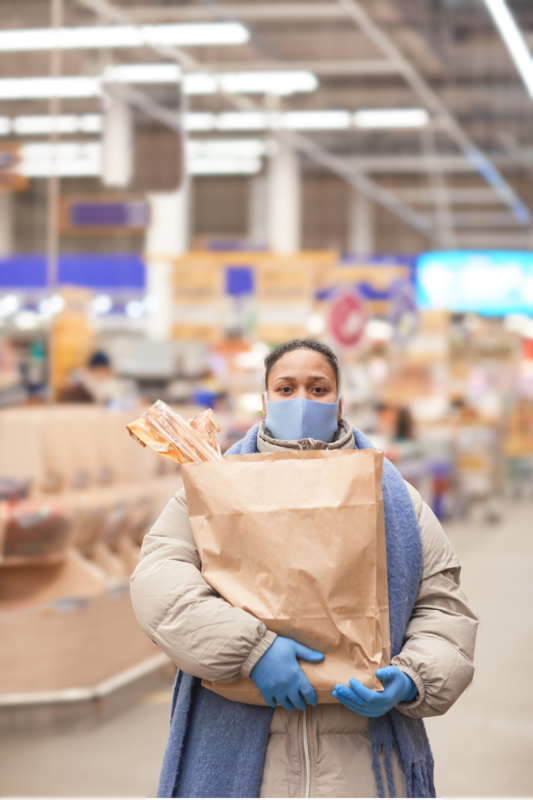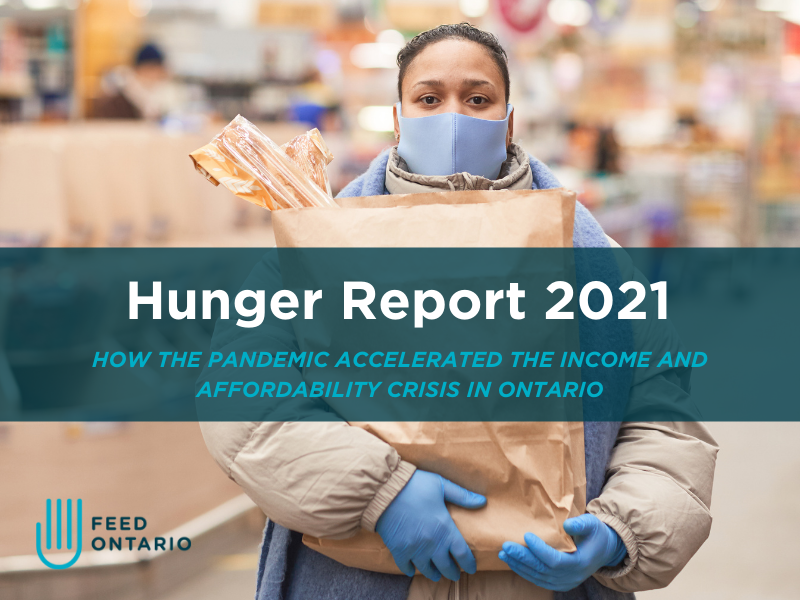Feed Ontario’s 2021 Hunger Report
The 2021 Hunger Report provides analysis of the data gathered by the Ontario food bank network through the Link2Feed client intake system between April 1st 2020 – March 31st, 2021. This year’s report looks at the barriers to the ‘Right to Food’ in Ontario and how the pandemic has accelerated the province’s income and affordability crisis, particularly for senior citizens and people with disabilities.
Click the links below for more information on this year’s Hunger Report and how you can take action:
Key Highlights | Recommendations for Change | Take Action | Learn More
Food Bank Use Data
- 592,308 adults and children accessed a food bank in Ontario between April 1st, 2020, to March 31st, 2021 – an increase of 10 percent over the last year and the largest single-year increase since 2009.
- Ontario’s food banks were visited more than 3,683,000 times throughout the year, an increase of 12 percent over the previous year.
- The proportion of senior citizens accessing a food bank in Ontario has grown by 36 percent over the previous year, and 64 percent since 2008. Senior citizens are nearly twice as likely to access a food bank compared to adults under 65 years of age.
- Ontario’s insufficient social assistance programs, precarious employment, and unaffordable housing are the primary drivers of food bank use:
- 59 percent of food bank visitors cite social assistance as their primary source of income.
- 44 percent increase in the number of people with employment accessing food banks for support in the four years leading up to the pandemic.
- 86 percent of food bank visitors are rental or social housing tenants with over 50 percent of food bank visitors citing the inability to adequately pay for housing and utilities costs as the primary reason for food bank usage.
Case Study: The impact of COVID-19 on food bank visitors with disabilities
- In surveying over 300 food bank visitors, it was found that:
- Over 60 percent of respondents have less than $100 left per month after paying for housing and utilities, including one out of five who indicated that monthly expenses currently exceed their monthly income
- 55% of respondents who self-identified as having a disability revealed that they did not receive any additional financial support, including provincial or federal COVID-19 benefits
Food Banks Services and Supports
- 91% of food banks provide programming and services beyond emergency food support
- Examples include, home delivery programs, specialty programs for children and youth, culturally or diet specific food options, income tax preparation, and more
Feed Ontario and the provincial food bank network know that food insecurity can only be reduce through strong public policies that ensure every Ontarian is able to access the income needed to afford today’s cost of living.
In order to ensure that food bank use does not continue to escalate, Feed Ontario is calling on the Government of Ontario to address the province’s income security and affordability issues immediately. The report provides detailed recommendations on the actions that the Province can take today, including:
- Improvements to Ontario’s social assistance programs
- Key investments in affordable housing, and
- Improvements to Ontario’s labour laws that support workers and the economy
You can help #FeedChange and support people in need across Ontario by sharing the findings of Hunger Report 2021 and Feed Ontario’s recommendations for change!
How Can I Participate?
- Contact: Call, email, or visit your MPP
- Social Media: Post our shareables and tag us @FeedOntario so we can boost it, as well as your MPP.
Who Should I Contact?
Your Own MPP:
Other Key MPPs:
Premier Doug Ford, @FordNation
Minister of Children, Community and Social Services, Merilee Fullerton @DrFullertonMPP
Parliamentary Assistant for Community and Social Services, Jeremy Roberts @JR_Ottawa
Minister of Labour, Training and Skills Development, Monte McNaughton @montemcnaughton
Minister of Municipal Affairs and Housing, Steve Clark @SteveClarkPC
If you are interested in learning more about hunger and poverty in Ontario, please see below:
- Hunger in my Riding Tool
- Hunger Map
- Cost of Poverty
- Previous editions of Hunger Report
- Our Recommendations for Change

